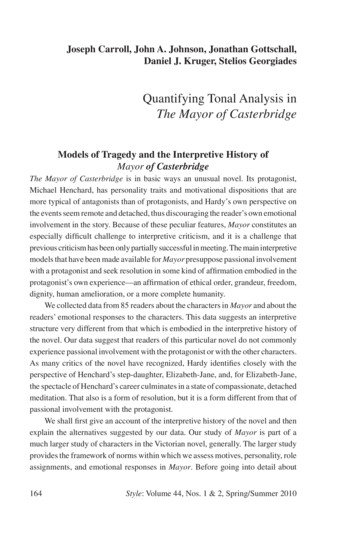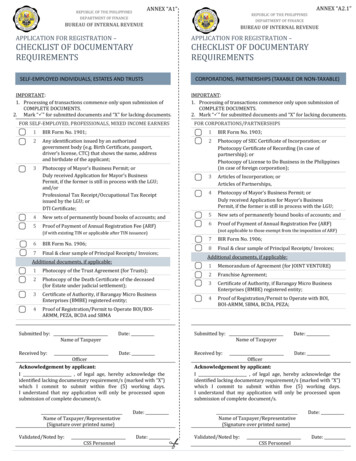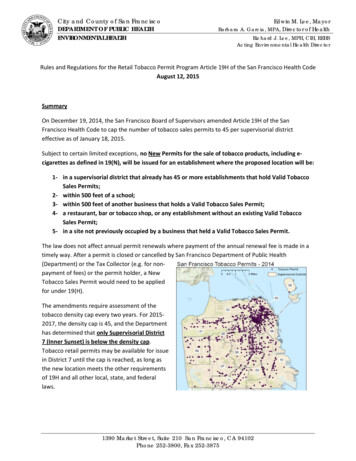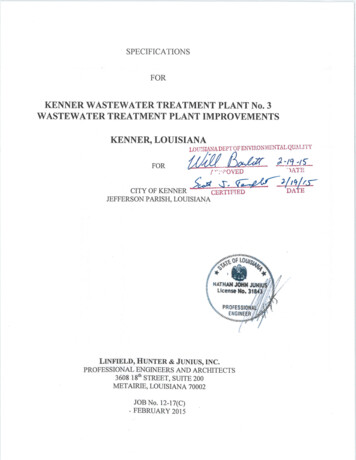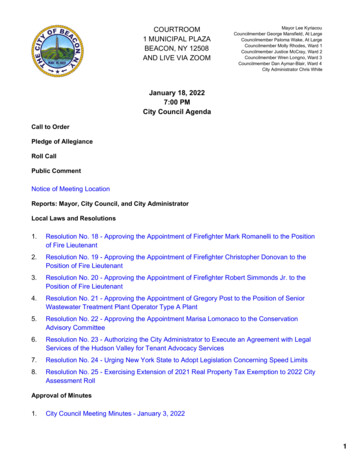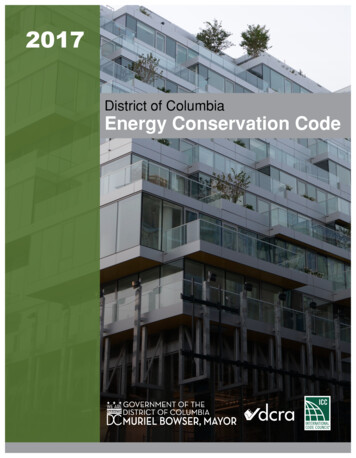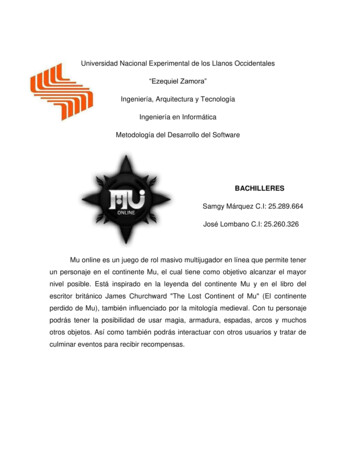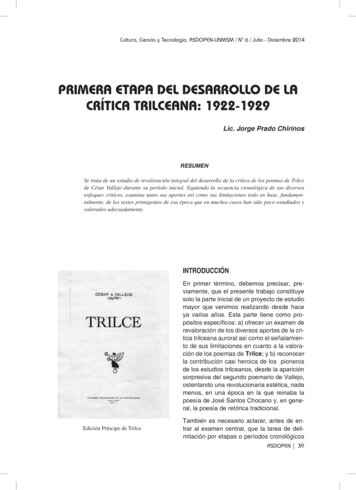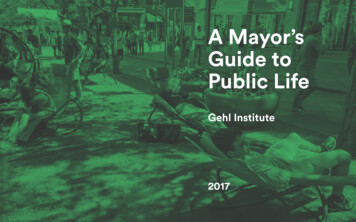
Transcription
A Mayor’sGuide toPublic LifeGehl Institute2017
What’s inthis guide?This guide shows how mayors can encourage vibrantpublic life.It’s broken up into five steps: Measure, Invite, Do,Evolve, Formalize.It features case studies from New York City,Pittsburgh, Denver, Lexington, San Francisco, St.Paul, and Copenhagen.
Five things youneed to know ifyou don’t readthis guide1 Public life is what happens in public spaces, on streets,and in between buildings.2 Public life thrives when all people can enjoy being inpublic together.3 A vibrant public life promotes health, makes our citiessafer, can lead to more civic engagement, can createeconomic opportunity and mobility, builds social capital,and connects people to their local communities.4 Cities that have a vibrant public life are morecompetitive and attract and retain talent.5 Public life needs to be tended to by a) paying attentionto how people feel about public spaces and what theydo there; b) by designing streets and public spacesthat encourage social activity; and c) by changing thepolicies, processes, and practices of a city to be morepeople-centered.
About UsGehl Institute’s mission is to transform the way citiesare shaped by making public life an intentional driverfor design, policy, and governance. We believe thatin order to make cities more equitable and just,public spaces should be made more accessible andwelcoming to more people. Our interdisciplinarywork combines research, advocacy, and networkbuilding.First launched in 2015 by Gehl, a privately heldurban design practice based in Copenhagen withoffices in San Francisco and New York City, GehlInstitute has set up independent operations as a501(c)(3) in New York City.
IntroductionWho is this guide for?This guide is for mayors and their staff. It makes the casefor why paying attention to and measuring what peopledo in public spaces matters. It also offers tactics and realworld case studies to help mayoral administrations getthings done.The challenges on the top of most mayors’ to-do lists—from reducing crime to building the economy to promotingpride of place—are all directly related to how well ourcities encourage public life. On a fundamental level, webelieve that removing barriers to participation and makingit easier for more people to spend time in public spacesis key to creating thriving, democratic cities. It’s a legacythat every mayor should aspire to.What is public life?Public life is what people create when they connect witheach other in public spaces—the streets, plazas, parks,and city spaces between buildings. Public life is about theeveryday activities that people naturally take part in whenthey spend time with each other outside their homes,workplaces, and cars.
Public life is composed of fleeting moments: sharing abench with a stranger, enjoying dinner in a park, greetingneighbors at the bus stop, or watching a live performanceon a street corner. Public life can be children playing ona playground, strangers giving directions, or protestersgathering in a plaza. For public life to flourish, the cityshould feel safe to walk in at all times of day—which,when more people choose to do so, makes our streets andpublic spaces safer. Ironically, when spaces are designedto be defensive and uncomfortable to certain groups, theycan become unwelcoming to everyone. Public life shouldbe accessible to people of all backgrounds, making for amore just, equitable, and vibrant city. Everyone has a rightto public life.What we know aboutpublic life:why do you love it? Often, it will be because it is a citywhere people enjoy being out and about. We know thisinstinctively.A robust public life can nurture a sense of communityas we learn to value our commonalities and theneighborhoods we call home. It helps to attract talent tothe city, increases economic competitiveness, and allowsfor active lifestyles by making walking and biking easier.Sharing public spaces can also promote tolerance aspeople who differ from one another coexist and interact. Itpromotes civic engagement and invites us to participate inthe life of our community.Research shows that a strong public life also builds thesocial capital that society needs to help people move outof poverty as well as to promote better health. The WorldHealth Organization defines health as a state of completephysical, mental, and social well-being and not merely theabsence of disease or infirmity. Planning a city to facilitateall three states of health is, in essence, a way to plan forpublic life.“[Copenhagen’s city leaders] worry about building theright kind of community to result in happier, connectedpeople with a great sense of civic well-being. They believeif you do that, the crime rate takes care of itself.” – TeresaTomlinson, Mayor of Columbus, GAHow to use this guidePublic life thrives when our city leaders create streets,parks, plazas, and public spaces that put the desires andexperiences of people first. Think about your favoritecity besides your own. What makes that city great, andWe know that when mayors enter office, they inheritprojects at different stages. Accordingly, A Mayor’s Guideto Public Life is broken into five sections: Measure, Invite,Do, Evolve, and Formalize. In each section, we offer tactics
and one or two relevant case studies. Reading through thismaterial will help you incorporate people-centered designand planning techniques at any point in your projects’timelines.Additionally, to help you make your case to colleagues andstakeholders, we’ve included a PowerPoint presentation ofrelevant case studies, available for free download online.Starting in the summer of 2017, we will also host ourresearch tools online, making it easier for anyone to carryout people-centered public space evaluations.If you would like to get in touch, please contact us atadmin@gehlinstitute.org!1 Raj Chetty and The Equality ofOpportunity Project have found thatthe quality of our neighborhoodsis the most important factor ineconomic mobility. Their researchshows that upward mobility (movingfrom the bottom fifth to the topfifth of income) is more likely whenchildren grow up in neighborhoodswith mixed incomes, good schools,high percentages of two-parentfamilies, shorter commute times,and increased access to civic life.Cities that had more neighborhoodswhere rich, middle-class, and poorfamilies lived alongside each otherwere the cities that made it morelikely for a child growing up in apoor family to experience economicupward mobility. The role of publiclife here is that its focus on buildingvibrant streets and spaces as agreat equalizer provides equitableopportunity for contact andexposure among people of differentbackgrounds.2 A 2016 study in the Lancet (theprestigious U.K. medical journal)showed that the urban environmenthas a direct effect on people’sphysical activity and health. Thestudy showed that “activitysupportive environments”—denserresidential development, proximityto parks, access to public transit—increase the amount of physicalactivity of the people who livethere by as much as 45–59% of therecommended weekly amount. (Thestudy compared fourteen citiesaround the world and controlledfor differences in climate andsocioeconomic status.) In short,planning public life directly leads toactivity-supportive environments,which in turn promote betterphysical health.
Measure
If you want to understand how to improve public spaces inyour city, don’t start from scratch. Start with measuring.When you measure how many and where people chooseto spend time in public spaces, as well as what they dobased on their current options, you get a better sense ofwhich design or policy changes might best contributeto a city or neighborhood’s public life. People-centeredmetrics enable you to make an evidence-based casefor change, creating buzz for projects and persuadingskeptics to get on board. Such data can also revealpreviously invisible or overlooked patterns to cityagencies.Of course, measuring people tells only part of the story.It should be combined with surveys, various forms ofengagement, and collecting quantitative data on thephysical makeup of public spaces. It’s also important tobe ethical about data collection—for example, keepingidentities anonymous and making the data available to thepublic.TacticsMeasure what people do—right where they do itBringing new people into the city planning process can betough. The channels through which citizens communicatetheir needs to city leaders are traditionally limited andoften cater to a narrow section of the general populace. Toexpand and diversify the voices engaging in city-making,leaders need to find new ways of soliciting feedback andincorporating residents into the development process.One option for city leaders is to go to the people, ratherthan expecting the people to come to them. By meetingpeople where they are, as part of their everyday routineout in the city, city leaders can better understand how thebuilt environment, policies, and regulations directly affectpeople’s behavior and sense of place.Define success through people-centered metricsThere is an old business adage that “you measure whatyou care about.” Most cities have detailed data oncars, such as the number of cars on the road, traveltime, areas prone to congestion, or the number andtypes of traffic accidents. Cities have not, however,traditionally collected what we call people-centeredmetrics, or metrics based on how people use and movethrough public space. This has resulted in a one-sidedunderstanding about how cities should be planned, oftenleading to pedestrian-unfriendly urban renewal efforts. Togain a holistic understanding of your city—including theactions, behaviors, and needs of residents—you need tocollect people-centered data. Asking “when, where, andwho” is the first step in understanding how to prioritizepublic-realm investments and how they affect people.
CASE STUDYNew YorkThere’s No Square There—ThePedestrianization of Times SquareNew York City is one of thedensest urban environmentsin the United States, and likemost American cities, it hasdetailed metrics for vehiculartraffic and intricate plans toreduce traffic congestion. Yetbefore 2008, information aboutpedestrians, cyclists, and howpeople spend time in the citywas not known. Working withlocal advocacy groups, the cityengaged hundreds of volunteersto visit main streets and spacesin four of the five city boroughs.Hundreds of thousands of peoplewere then “counted” while theywent about their daily routines.Using this methodology, cityofficials were able to understandhow streets and other publicspaces were performing forpeople. One key finding wasthat 90 percent of the space inTimes Square was dedicated tocars, even though 90 percent ofthe movement through TimesSquare was actually on foot.Something was not right aboutthe math. One of Mayor MichaelBloomberg’s favorite mottoswas, “In God we trust. Everyoneelse bring data.” Equipped withthis data, the mayor now hadthe empirical evidence to funnelinvestment and channel politicalcapital toward bold ideas like
creating new public spacesalong Broadway between 14thand 57th Streets, including inTimes Square.From Times Square to Flushing,Queens, new design outcomeswere subsequently developedacross the city that dramaticallyimproved public life throughsimplifying intersections,shortening crosswalks, organizingand defining traffic lanes, andseparating conflicting mobilitymovements (e.g., cars turningand not yielding to pedestrians).Multiple people-centered metricsprovided the framework to makebold decisions that improvedpublic spaces and served multiplecitizen interests.The pedestrianization of TimesSquare—or, stated differently,its transformation into an actualpublic square—increased thenumber of people who stayedin the area’s public spacesby 84 percent and improvedvehicular traffic flows along theavenues in Midtown Manhattan.Additionally, businesses sawimproved foot traffic, increasedsales, and decreased vacancyrates. In a survey, 42 percentmore people said they shopped inthe neighborhood and 74 percentsaid that Times Square hadimproved dramatically. In termsof safety, pedestrian injuries fellby 35 percent in part due to 80percent fewer people walkinginto the roadways.Understanding the peoplecentered metrics in Times Squarehas set a precedent for cities inhow to measure, achieve, andthen evaluate changes beingmade to the built environment tobetter suit public life.
Invite
Citizens are often asked to weigh in on how projects shouldtake shape, but this engagement typically takes place onlyafter the projects have already been defined. Citizens areasked, for example, whether they prefer “option 1, 2, or3” but do not have a say in what types of projects theyactually want to see implemented. The format and timing ofthis engagement generally caters to a narrow portion of thepopulation and fosters an environment in which NIMBYismcan flourish. By inviting more people to constructivelyparticipate in the planning process, engagement not onlybecomes more inclusive, but also more effective.TacticsProvide a deliberate invitation to people to participatein the processPeople can sense where they are wanted. We aresurrounded by signals large and small that tell us whetheror not we are welcome. To foster public life, every personneeds to feel that they are welcome to participate in thecreation and design of public spaces and to participate inpublic life. Widespread awareness among constituents ofhow decisions are made, where meetings take place, andhow to attend is crucial in drawing out feedback.Invite participation by reducing barriersReducing barriers to participation is central to makingpeople feel they are truly invited to be a part of theplanning process. A park is only welcoming if it is easy toaccess and comfortable to spend time in. Similarly, peoplewon’t speak up if they feel that they won’t be listenedto. Rather than expecting citizens to come to them, cityleaders must go to citizens in order to receive more diverseinput. Moving public meetings directly to project sites,convening open forums on a regular basis, providingAmerican Sign Language translators, and being flexible andopen to addressing unique, neighborhood-specific agendasrather than standardized city agency priorities can all helpensure constructive insight from diverse groups.
CASE STUDYPittsburghCalling All Constituents! The “Mayor’sNight Out/Mayor’s Night In” ProgramsIn 2014, Mayor Bill Pedutoof Pittsburgh invited cityresidents to meet with himand his staff through his“Mayor’s Night Out/Mayor’sNight In” programs. Insteadof expecting people tomake special trips to attendhearings or meetings held bythe city, he went to placeswhere the public spent timeand made an effort to letpeople know exactly wherethey could find him.During Mayor’s Night Out,Mayor Peduto and his staffrotate through different cityneighborhoods and inviteresidents to voice ideas andconcerns on neighborhoodturf. Additionally, the mayor’sstaff streams meetings onlineand over the radio, sending aclear message that the mayoris interested in hearing fromall constituents.Similarly, on Mayor’s NightIn, City Hall opens itsdoors for residents to visithis offices and share theirthoughts. The benefits ofsuch deliberate invitationshave been tremendous.At the first Mayor’s NightIn, the mayor and other city
department directors heardconcerns about quality-of-lifeissues that residents thoughtshould inform mayoral priorities.Previously, the nuances of theseissues would get lost in City Hallmeetings, in part because theyweren’t necessarily important tothose residents who felt welcometo attend. But in this forum,residents cited concerns aboutshuttered neighborhood schools,a lack of jobs and educationalprograms, debris on local streets,and other issues that the mayorcould tackle directly.The Mayor’s Night Out/Mayor’sNight In events were successfulin that they nurtured two-waycommunication and furtherdemocratized the city-makingprocess. Ultimately, the programgave Mayor Peduto a chance toaddress a lack of transparencycreated by the previousadministration. In obtaining moreof the public’s trust, the mayorwas able to introduce his “takeaction” approach to governancein a more compelling andeffective way.4 NIMBY stands for: Not In My Backyard.
Do
While understanding the value of public life is crucial,actually implementing design and policy changesthat improve public spaces for everyone is easier saidthan done. In the “Invite” section, we described waysto proactively incorporate the voices of differentstakeholders into the city-making process. Here, wedescribe action-oriented approaches to producing realoutcomes in space: starting with temporary interventionsthat build on what already exists but always workingtoward long-term, systemic change.TacticsBe experimental with low-cost, low-risk test projectsUse simple, temporary test projects to explore designpossibilities and foster public support for more longterm iterations. Such “prototypes” or “pilot projects” cantake many forms—a recurring event that momentarilyopens up car lanes to pedestrians, quick improvementssuch as painting a bike lane or widening a crosswalk, orthe addition of seating and programming in an otherwiseunused public space, for example. It’s important to workclosely with community groups on these efforts, ensuringthat they will be stewards and champions of the space.But of course, not everyone likes change; small businessowners, for example, may fight projects that cater topedestrians at the expense of parking spaces. Creating alive test of a new idea—as opposed to installing somethingmore costly and permanent—lowers the stakes and canwin people over, lead to community empowerment, andultimately, a shared sense of ownership.Build on what already exists in a placeIt’s easy to overlook local assets that exist in your ownbackyard. Landmarks, access to open space, knowninstitutions, or community centers may not have animmediate relationship to the big vision or projectguidelines, but they can be key building blocks. Similarly,people and the activities they already do in publicspaces—whether or not they are permitted—can be builtupon. Sitting on ledges, cutting across lawns, turningchairs around to face the street, barbecuing, evenskateboarding—these are all things that signal personaldesires for specific uses of public space. Rather thanstarting from scratch, identify existing assets and buildupon what people are already doing. Welcome peopleand their ideas.
CASE STUDYDenverFostering Foot Traffic—The 16th StreetMall Pilot ProjectThe 16th Street Mall is amajor commercial streetin the heart of Denver’scommercial district.Surrounded by restaurantsand shops, the mall wasclosed to car traffic exceptfor a free bus shuttle thatconnected Denver UnionStation to the Civic Center.For many years, the mall wasconsidered highly innovativeand a tourist destination. But,despite being an efficienttransit corridor, a lack of foottraffic made it difficult forretailers to stay in business,and safety concerns plaguedthe street. Ultimately, the16th Street Mall offered fewreasons to spend time there,with the exception of theweekday lunch hour, whenthe sidewalks were throngedwith downtown professionals.Meanwhile, continuousmaintenance and repair costthe city millions of dollars ayear, with little activity on thestreet to justify the spending.Available federal fundingprovided an opportunity fornecessary improvements, butnegotiating the competinginterests of transit operations,historic preservationists,and property owners provedchallenging.
To show that the street wasworthy of transformation andadditional investment, theDowntown Denver Partnershipcreated a temporary pilotprogram for the 16th StreetMall to bring numerousparties together and move theconversation forward. Someagency leaders were dubious thatthe 16th Street Mall could ever bea lively place. So, beginning withjust two Sundays in 2014, fourSundays in 2015, and finally fiveweekends in 2016, the bus shuttleon the mall was temporarilymoved to other streets. TheDowntown Denver Partnershipcollaborated with the regionaltransit agency to reallocate thespace on 16th Street to be morepedestrian-friendly with seatingand a wide range of locallyproduced art, food, and culturalprograms.The Downtown DenverPartnership and the Office of CityPlanning measured use, users,and other factors before, during,and after the pilots and foundpositive benefits. Before thepilots, people tended to go to themall to catch the free bus shuttleand rarely lingered. Duringthe special event weekends,however, overall activity levelsincreased by upwards of 62%,with an average of 27 morepeople per block at any giventime. On Saturday evenings,the average number of peopleincreased from 57 to 93 perblock. Typically, only 37% ofvisitors to the mall lingered atoutdoor restaurants and cafes.But during the pilot project,the number of people sittingoutdoors increased by 194%.Additionally, the changes led toan increase in gender and agediversity: before the pilot, thepedestrian makeup was roughlytwo-thirds men, and very fewchildren or seniors were visibleon the street. During the pilot,the gender demographicsbecame more equally distributed,and there were 65% morechildren under 12 and 40% moreolder adults.Notably, once transit agencyleaders and staff experiencedthe benefits of having morepedestrians in the middle of theirdowntown, they became lessstrident about their primary goalof protecting the transit corridorfrom Denver Union Station to theCivic Center (a connection theyhad previously considered criticaland largely non-negotiable).They saw that rerouting thebus line did not result in failedconnections, and became
more open to pedestrian-friendlyimprovements on the 16th StreetMall.Competition among differentpublic agencies for limitedresources is inevitable in any city,but this pilot project created ashared understanding of potentialimprovements that could benefitmultiple interests simultaneously.
CASE STUDYLexingtonTesting The Waters—SplashJAM As aCatalyst for PlayLexington’s population isgrowing rapidly, but its electedofficials and stakeholders havestruggled to create a commonvision and plan of action forcity investments. Mayor JimGray understood that to createpositive change, initiativesshould be designed to achievemultiple goals, including equity,public health, and safety.A public-space analysisconducted by Gehl (the privateurban design practice) in thespring of 2015 revealed suchan opportunity. Childrenwere playing in a fountainin Thoroughbred Park,despite rules prohibiting thisactivity. The park sits at theintersection of major routesinto downtown and bisectsfour neighborhoods of verydifferent socioeconomiccompositions. Most of theusers were children from anearby, predominately lowincome community whodidn’t have other places toplay, especially during thesweltering summer months.The city found this behavior,while understandable, bothunsanitary and dangerous.Rather than issue tickets fortrespassing, Mayor Gray
embraced this activity as acatalyst for meaningful action.The children’s play in the fountainprompted the city to invest inauthentic, local public life andcreate more plays areas foryoung people in Lexington. Thelocal Downtown DevelopmentAssociation (DDA) initiated aprocess to engage a wide rangeof stakeholders, asking themwhat type of water-play facilitiesthey would be most interestedin seeing. With the supportof national and communityfoundations, local designers, andcity officials, the DDA createdSplashJAM, a temporary waterpark near Thoroughbred Park,where the initial play was takingplace. The water park includedaccessibility ramps, picnic tables,and beach umbrellas, as wellas on-site changing rooms andrestrooms.To understand how SplashJAMsucceeded and how it could beimproved, the water park wasevaluated using Gehl Instituteresearch tools. The evaluationsshowed that SplashJAMincreased the space’s diversitybased on education and incomeand attracted people of differentraces and ethnicities fromacross the city. In this way,action was not only motivatedby local culture and need, butit also provided a shared set ofexperiences for a diversity ofstakeholders. The evaluationsalso found that 80% of the visitorsto SplashJAM had never or hadrarely visited the park before thepilot, with 71% of the visitors nowreturning weekly. In fact, beforeSplashJAM, an average of onlyeight people were in the park atany point throughout the day;during the pilot, this numberincreased to over 23 people perhour. Finally, this intervention ledto significant increases in walking,with 85% more people walkingand spending time in the area.This formula—of first studyingwhat public life already exists,then taking action to accentuatethat activity, and finally evaluatingthe impact—is an approach thatboth the city and DDA are nowapplying to multiple projects largeand small across Lexington.
Evolve
Projects for improving public spaces should beapproached with flexibility. They can be broken downinto multiple stages, with each stage involving anevaluation process, thus allowing the projects to improveover the course of their implementation by respondingto previously unknown conditions. This strategy notonly makes the projects more sensitive to dynamics onthe ground, but also enables greater experimentationfor designers, event programmers, and agency staff.Moreover, it allows residents to voice their feedback atmultiple project stages.TacticsAllocate sufficient funding for project evaluations ateach iterationWhile it’s easy to embrace the ethos of the Jane Jacobsquote “the city is never finished,” it’s more difficult tomake this a reality with funding and resources. Breakingdown the project-delivery timeline into several iterationscan reveal what’s possible, create memorable sharedexperiences for residents, and inform future concepts.Furthermore, inviting citizens to test initiatives directly(before a large investment is made) can reduce risk andhelp ensure investments are used most effectively tomaximize positive impact. The ways in which citizensuse a project—ways that are often unimagined andunintended by the project instigators—are crucial todetermining its success. Project monitoring, evaluation,and reimagining should be an ongoing process becausethe way people use the city is constantly evolving. Ourcity-making projects should embrace, and plan for, thenotion that the city is never finished.Make it easier for citizen input to be positive, meaningful,and constructiveTraditional development processes place difficultdemands on citizens, expecting them to understandcomplex drawings and concepts and provide meaningfulinput with incomplete information. Instead, ask citizensquestions such as, “What is your favorite place in the cityand why?” And: “Which of the city qualities identified doyou want to see more of in your neighborhood?” Citizenscan provide feedback on topics they are experts in.Responses to these questions are naturally more actionoriented and create opportunities for citizens to definethe success criteria for projects.
CASE STUDYSan FranciscoPersuasion Through Prototyping—Better MarketStreet and the Prototyping FestivalMarket Street is one of themost congested yet directroutes through San Francisco’sdowntown. It serves multiplebus, transit, and trolleylines while simultaneouslyfunctioning as the civic spineof the city, connecting theMission to the Embarcadero.In 2010, the city launched its“Better Market Street” initiative.But after three years, cityagencies and Mayor Ed Leehad expended a great deal ofpolitical capital with few signsof physical improvementsto show for it. A handful ofscenarios were developed, yetthe city’s preferred option wasalso the most expensive one,and it remained unfunded.Concurrently, a lengthyenvironmental review processfurther delayed large-scalestreetscape and transportationimprovements.The Mayor’s Office of CivicInnovation and the PlanningDepartment explored lighterforms of interventionsthat could show progressand capture the public’simagination, eventuallyinforming longer-terminvestments. The group
developed a concept calledLiving Innovation Zones: itidentified ten “zones” alongthe two-mile stretch of MarketStreet, found various citizengroups and cultural institutionswith an interest in positivelycontributing to the vitality ofthe street, and streamlined thepermitting process throughwhich the organizations couldinitiate their programs. Thezones along the street provided“canvasses” for a broader set ofstakeholders to reimagine howthe street could serve as both apublic space as well as the city’stransit backbone. This initiativecreated an opportunity to testvarious ideas from the BetterMarket Street design conceptswhile the city searched foradditional funding and embarkedon the environmental reviewprocess.Bit by bit, the concept evolved.The first zone, opened in 2012and curated by the ExploratoriumScience Museum, has sincebeen scaled up to five zones,and is buoyed by the advent ofthe Market Street PrototypingFestival. This three-day festivalwas initially launched in 2013as an activist event by the GrayArea Foundation for the Artsand was adopted more formallyas a partnership between thePlanning Department and theYerba Buena Center for theArts in 2014. Its latest iterationfeatured 50 projects—fromexperimental benches tointeractive fountains to publicbathrooms to play areas—bycommunity members. Leveragingfunding from foundations, thecity-sanctioned event provided aplatform for citizen engagementthat made use of the creativity,entrepreneurship, and energyof residents in a way traditionaldesign processes cannot. Toinform future events and designtechniques, the city evaluatedthe festival prototypes withGehl Institute tools to see whichinstallations worked best atfostering social interaction.The festival’
this guide 1 Public life is what happens in public spaces, on streets, and in between buildings. 2 Public life thrives when all people can enjoy being in public together. 3 A vibrant public life promotes health, makes our cities safer, can lead to more civic engagement, can create
